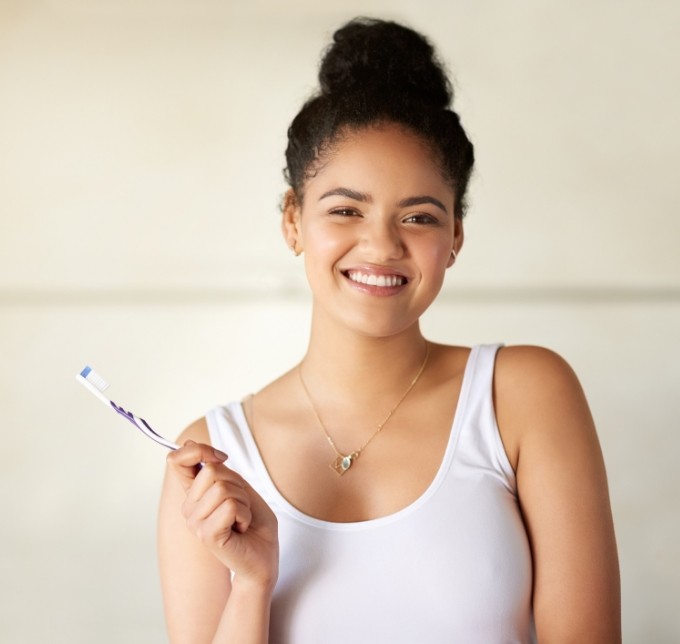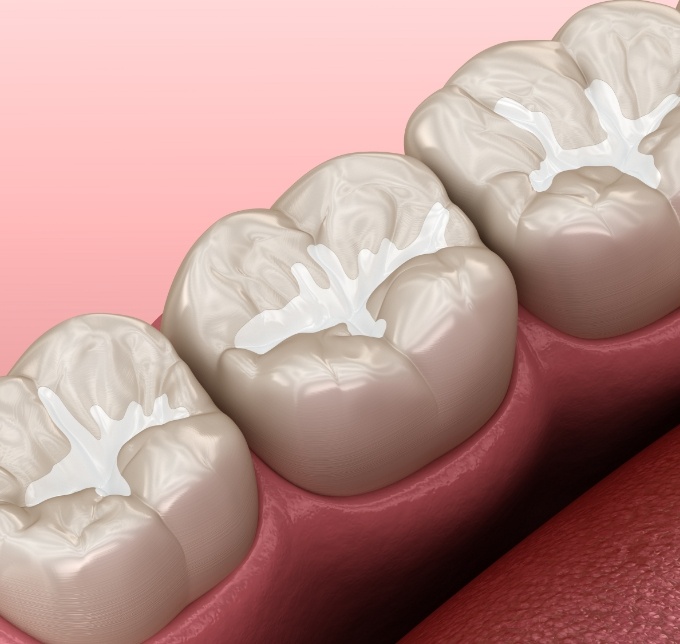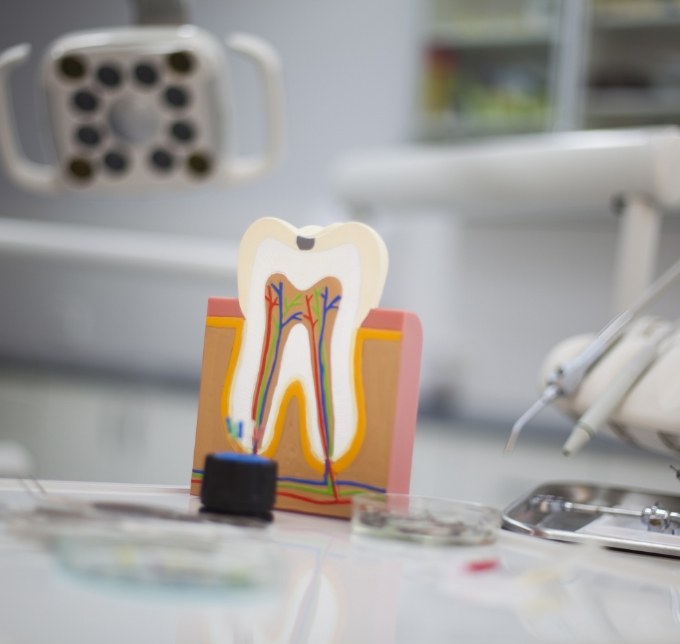Dental Treatment Post-Op Instructions Albuquerque
Taking Care of Your Smile After Treatment
When undergoing restorative care with Dr. Boehmer, there are steps patients can take following their appointment to improve their comfort and maximize the long-term success of their results. Please review our detailed post-operative instructions below, and don’t hesitate to contact us at our dental office in Albuquerque if you are experiencing any significant discomfort following your procedure.
Dental Crowns & Bridges At-Home Care

Crowns and bridges usually require a couple of appointments to complete. During the first appointment, the teeth are prepared. Temporary crowns or bridges are placed to protect the teeth while the custom restoration is being made. After each appointment, when anesthetic has been used, your lips, teeth, and tongue may be numb for several hours after the appointment. Avoid any chewing until the numbness has completely worn off.
It's normal to experience some hot, cold, and pressure sensitivity after each appointment. The removal of tooth structure and the placement of new materials may result in an adjustment period. If your teeth are sensitive to temperature or pressure, use a desensitizing toothpaste. Your gums may also be sore for several days. Rinse three times a day with warm salt water (a teaspoon of salt in a cup of warm water) to reduce soft tissue soreness and irritation. Ibuprofen or Tylenol should ease any discomfort during the adjustment period. Remember, any food that could chip, crack, or damage your natural teeth can do the same to your new porcelain restorations.
Temporary Dental Crown Care
Your temporary crown serves two purposes. It maintains the natural shape of the tooth and protects the preserved structure. When wearing a temporary crown, please avoid eating anything sticky or hard, as well as foods that could cause the temporary crown to break or become unattached (peanuts, caramels, etc.). No chewing gum! Here are a few home care instructions you will need to follow.
Brushing & Flossing Teeth
Brush at least two times daily. When flossing, pull the floss out from the side instead of pulling up to avoid loosening the temporary crown. Your permanent restoration may be flossed like normal.
If your temporary crown does come off, please contact our office as soon as possible to have it re-cemented. It will only take a few minutes. If your temporary crown comes off and you are unable to get to our office, dry the tooth with a tissue, line the temporary with a small amount of Vaseline or toothpaste, and place the temporary back on the tooth. The temporary will only fit in one direction. The longer side usually faces towards the cheek.
We are looking forward to seeing you soon and delivering your new, permanent crown. If your crown or bridge feels uneven, if you have persistent aching, or if you have any other questions or concerns, please call our office.
Full-Mouth Reconstruction At-Home Care

Remember that it will take time to adjust to the feel of your brand-new bite. When the bite has been altered or the position of the teeth has been changed, it takes several days for the “brain” to recognize the new position of your teeth and their thickness as normal. If you continue to detect any high spots or problems with your bite, call us so we can schedule an adjustment appointment.
It's normal to experience some hot, cold, and pressure sensitivity. Removing tooth structure and the placement of new materials may result in an adjustment period. If your teeth are sensitive to temperature or pressure, use a desensitizing toothpaste. Your gums may also be sore for several days. Rinse three times a day with warm salt water (a teaspoon of salt in a cup of warm water) to reduce soft tissue soreness and irritation. Ibuprofen or Tylenol should ease any discomfort during the adjustment period.
Your speech may be affected for the first few days. You will quickly adapt and be speaking normally again soon. You may notice increased saliva flow as well. This should return to normal within a week.
At-Home Oral Care
Daily plaque removal is critical for the long-term success of your dental work. Daily brushing and flossing are a must. Regular cleaning appointments in our office are also critically important. We’ll use the appropriate cleaning abrasives and techniques for your specific esthetic work.
Remember, any food that could chip, crack, or damage your natural teeth can do the same to your new cosmetic restorations. Avoid sticky candies and any unusually hard substances like peanut brittle, ice, pencils, and fingernails.
Tea, coffee, red wine, berries, and tobacco products can all stain your teeth, as well as your new restorations. Brushing after consuming will help minimize staining.
Let us know if you grind your teeth at night or engage in sports so we can make you a custom mouthguard. Adjusting to the look and feel of your new smile will take time. If you have any problems or concerns, we always welcome your questions.
Tooth-Colored Fillings At-Home Care

Chewing and Eating
When an anesthetic has been used, your lips, teeth, and tongue may be numb for several hours after the appointment. Avoid any chewing until the numbness has completely worn off. You may begin chewing right away after receiving white fillings since they set completely on the day of your appointment.
Brushing and Flossing
Brush and floss normally. It’s normal to experience some hot, cold, and pressure sensitivity after your appointment. If your teeth are sensitive to temperature or pressure, use a desensitizing toothpaste. Your gums may also be sore for several days. Rinse three times a day with warm salt water (put a teaspoon of salt in a cup of warm water) to reduce soreness and tissue irritation.
When to Call Us
If your bite feels uneven, if you’re experiencing excessive sensitivity or discomfort that increases or continues over time, or if you have any other questions or concerns, please call our office.
Root Canal Treatment Care Instructions

It is important to follow these recommendations to ensure proper healing after root canal treatment.
Temporaries
If we placed a temporary filling or crown in your tooth, avoid chewing for half an hour to allow the restoration to harden. To keep your temporary restoration in place, avoid eating hard or sticky foods. It is not a problem if a small portion of a temporary filling wears away or breaks off. However, if the entire filling wears out or if your temporary crown comes off, call us to have it re-cemented or replaced. It is important to complete the permanent restoration as soon as possible following root canal therapy.
Chewing and Eating
If we used an anesthetic during the procedure, avoid chewing until the numbness has completely worn off. Your lips, teeth, and tongue may be numb for several hours.
Brushing and Flossing
Continue brushing and flossing at least two times a day.
Medications and Discomfort
If antibiotics were prescribed, continue to take them for the indicated length of time, even if all symptoms and signs of infection are gone. To control discomfort, take medicine before the anesthetic wears off. Over-the-counter medication such as Tylenol or Ibuprofen will generally handle any discomfort. It is normal to experience some tenderness for several days after a root canal appointment, especially when it comes to pressure-related sensitivity. Reduce discomfort or soft tissue irritation by rinsing with warm salt water three to five times daily. Use about one teaspoon of salt per glass of warm water.
When to Call Us
If your bite feels uneven, if you’re experiencing excessive sensitivity or discomfort that increases or continues over time, or if you have any other questions or concerns, please call our office.
